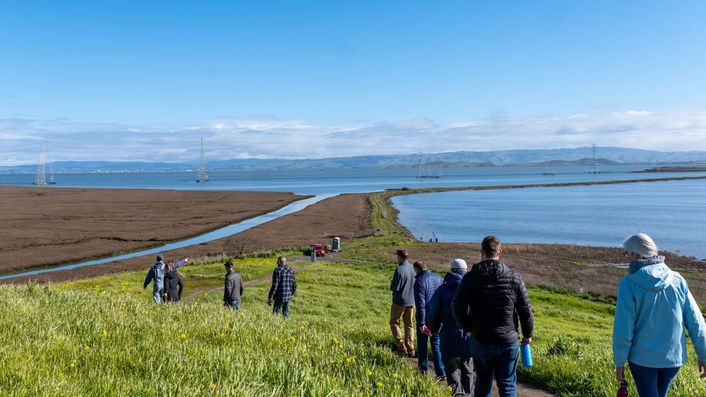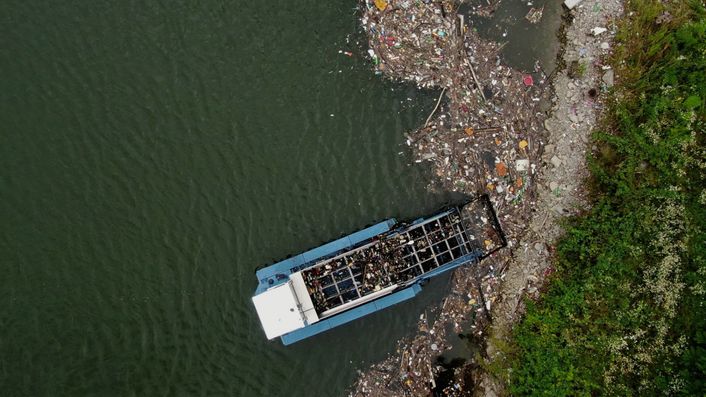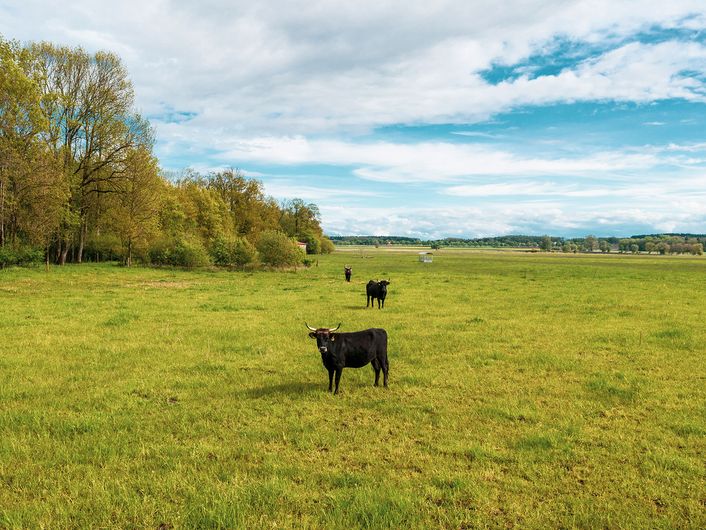Columns of biodiversity: Sustainable projects for species protection and environmental education
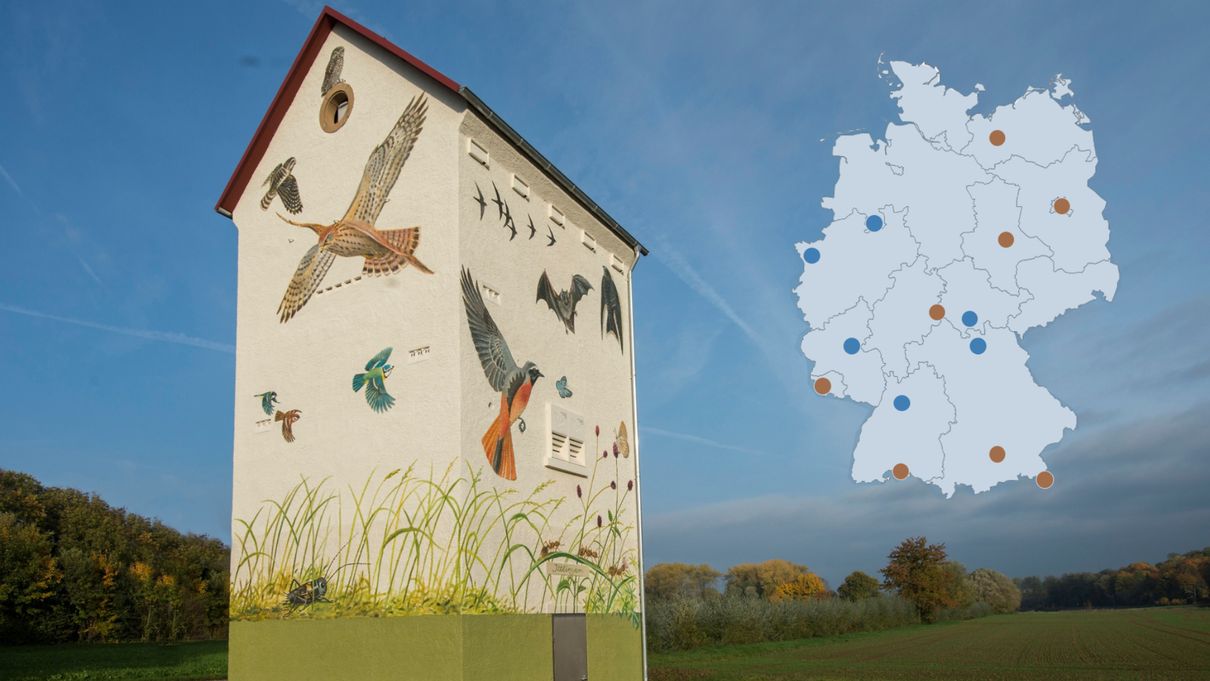
In the nationwide-designed environmental project, disused transformer substations will be converted sustainable in stages to “Columns of Biodiversity”. For this purpose, valuable habitats and breeding spaces are created on the buildings for regionally specific (main) wildlife species. By way of example, a particular highlight is a newly developed bat thermal chamber, which provides a valuable refuge for these animals.
Species-protecting Towers
Modern species protection and lively environmental education
Disused transformer houses are gradually converted into “steles of biodiversity”. For this purpose, valuable habitats and breeding opportunities for regionally specific native animal species are created on the buildings. A special highlight, for example, is a newly developed bat thermal chamber, which is a valuable retreat for these animals.
Transformer station environmental project - art meets sustainability
In order to sensitize the public to the topic of biodiversity and species protection, the transformer houses have been painted with mostly oversized animal and plant graphics that catch the visitor's eye from afar. The aim is to arouse the visitor’s curiosity to learn more about the environmental education project and the biological diversity of the local fauna.
Modern Technology and Environmental Education
The former transformer towers are equipped with modern technology, which supports an up-to-date information transfer. Today people and future generations in particular, are more and more separated from nature. The names and required living conditions of our fellow creatures are barely known.
It is also for this reason that, in terms of project content, it was important to integrate educational programs, such as those for kindergartens, into the project from the start. Thus children learn why it is worthwhile to engage in species protection.
Showing responsibility for a more visible species protection and environmental education
Working together, the project partners “Artenschutz in Franken®” (Association for Species Protection in Franconia) and Audi Environmental Foundation developed the idea of creating “beacons” for species protection all over Germany. Besides concrete species protection, the aim of the project is to inform as many people as possible outside of education centers about this important topic.
The pilot phase started in 2014 with three selected transformer towers in Baden-Württemberg, Bavaria and Thüringen. They were extensively redesigned with the technical guidance of the purely voluntary organization, “Artenschutz in Franken®”. Last but not least, the enthusiasm of the local project partners has contributed to the successful completion of the pilot phase of Columns of Biodiversity and to giving the starting signal to the selection of other suitable objectives. The website https://www.stele-biodiversitaet.de/ gives an overview of this innovative environmental project, provides information on the locations and wants to inspire many other people to create similar ideas and concepts based on the model of the Columns of Biodiversity, thus providing a further contribution to the preservation of biodiversity. Many projects were awarded as projects of the UN Decade of Biodiversity.
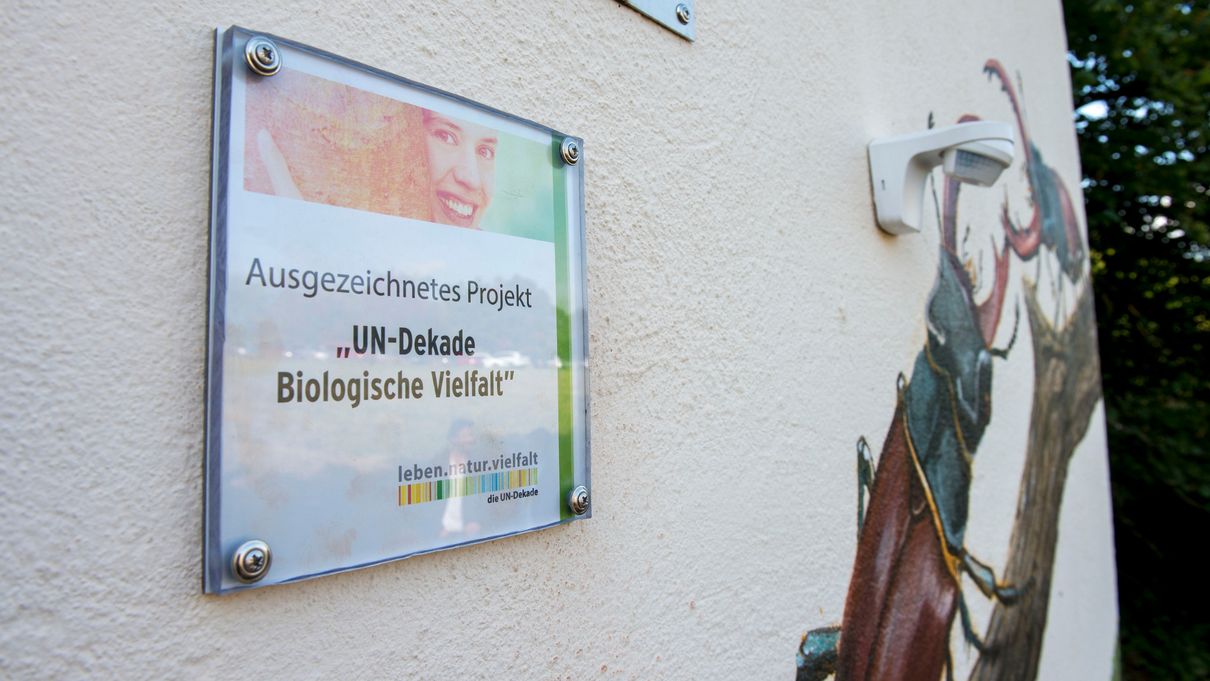
Species protection center opened at “Tierpark Weeze”
Species protection center opened at “Tierpark Weeze”
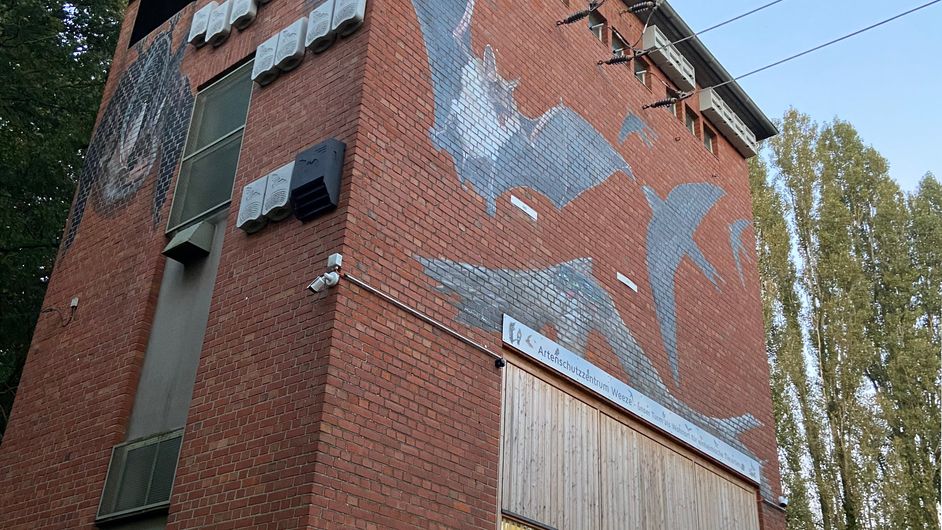
In October 2021, the disused transformer tower at “Tierpark Weeze”, which had been converted into a "Stele of Biodiversity", was opened, another highlight among the species protection towers artistically designed by the association “Artenschutz in Franken”. During his first visit in 2015, Thomas Köhler, chairman of the association, recognized that the disused transformer house at the zoo is an ideal location for another project of species protection and tangible environmental education. This year, thanks to many volunteers, the conversion could take place. Project participants were "Artenschutz in Franken", “Tierpark Weeze gGmbH”, the municipality of Weeze, the owners of the castle ruin Hertefeld and the children's and youth leisure facility “Weezer Wellenbrecher”. The project was significantly supported by the German Postcode Lottery and the Audi Environmental Foundation.
Michael Horn and Carsten Reckziegel artistically illustrated the exterior walls and especially the interior of the newly created species protection tower with outstanding lifelike representations of the landscape of Weeze and the local animal species. Bat quarters and nesting boxes for swifts were attached to the outside of the tower. Nearby, a wild bee wall was installed, and sand lizards and grass snakes find a new habitat created from stones and deadwood piles. In addition, a wild bee and a bat educational trail with descriptive information boards were designed on the outdoor area, providing a further element of environmental education. All these different components together form a whole species protection center that completes the “Tierpark Weeze” in a perfect way.
Species-protecting tower in the castle town of Kastellaun
Species-protecting tower in the castle town of Kastellaun
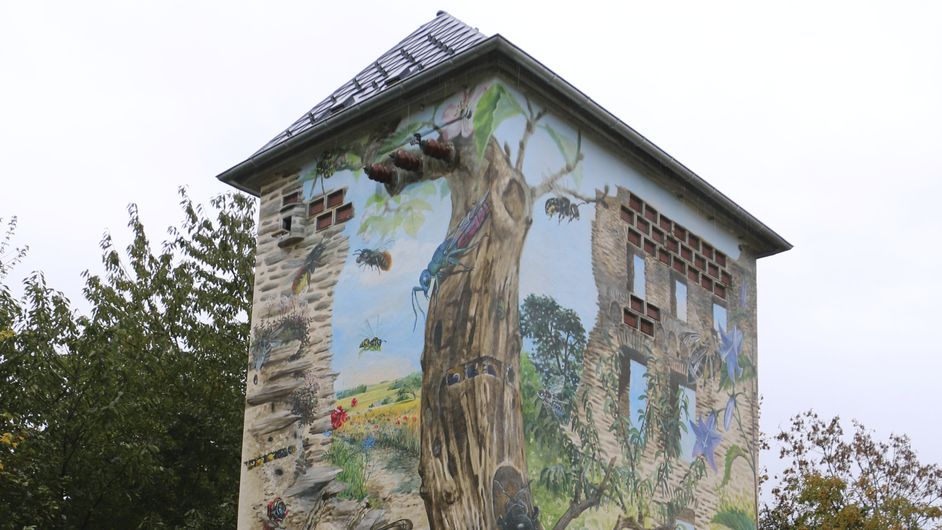
Official presentation and handing over of the Column of Biodiversity
The former transformer substation “In den Bergbitzen” (In the Bitzen hill) in Kastellaun, which was converted in the summer to a “Column of Biodiversity”, was officially handed over on October 24th, 2016. Since 2014, the project partners Verband Artenschutz in Franken® (Association for Species Protection in Franconia) and the Audi Environmental Foundation have been gradually creating “Beacons of Biodiversity”, in addition to their concrete species protection activities, thus providing environmental education material that can be experienced. The pilot phase began in 2014 with the conversion of three transformer substations in Baden-Württemberg, Bavaria and Thüringen.
This year the project has now been successfully carried forward, by converting the former transformer substation in Kastellaun to the “Wild Bees Tower”. Wild bees and bats have already moved into the new environmental education station and a kestrel has already inspected the building, which will become its new home. The St. Helena Kastellaun Catholic Kindergarten has adopted the “Wild Bees Tower”.
Virtual tour of the conservation tower.
Species protection project in Ittlingen
Species protection project in Ittlingen
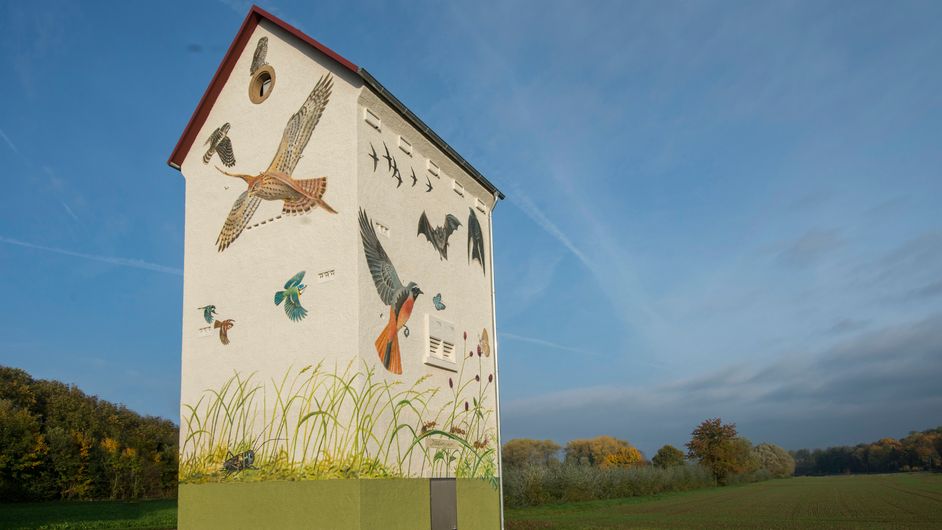
New habitat for endangered animal species
The Audi Environmental Foundation inaugurated a transformer substation for endangered animal species in Ittlingen, near Heilbronn, on 24th October, 2015. As part of the “Columns of Biodiversity” project, the Foundation in collaboration with the Association for Species Protection in Franconia have completed buildings in recent months - in Baden-Württemberg, Bavaria and Thüringen. In addition to concrete species protection, environmental education is also a focus of the project. The aim is, with non-profit institutions, to familiarize people in their own neighborhood with local nature and to generate enthusiasm for the preservation of biodiversity. In Ittlingen, the Audi Environmental Foundation is working together with the St. Thomas Association and the Community Family Center. In the nationwide project, the Foundation has so far converted three former transformer substations in Ittlingen, Suhl and Bad Staffelstein to provide valuable living spaces for many animal species, some of which are endangered. In Ittlingen. which lies in the upper valley of the River Elsenz, these are predominantly pipistrelle bats, barn owls and little owls. To draw the attention of visitors and walkers to environmental protection, the artist Michael Horn has painted the converted transformer tower with large-scale animal and plant motifs. An information board provides information on the project and the animal species, for which it provides shelter. A flyer provides an overview of the environmental project and the three “Columns of Biodiversity”. QR codes can be used to download a virtual tour with comprehensive information on the species protection project. In Suhl und Bad Staffelstein, interested people can also obtain information via multimedia sources, e.g. by observing animals via webcams.
Virtual tour of the conservation tower.
Species-protecting tower in Bad Staffelstein
Species-protecting tower in Bad Staffelstein
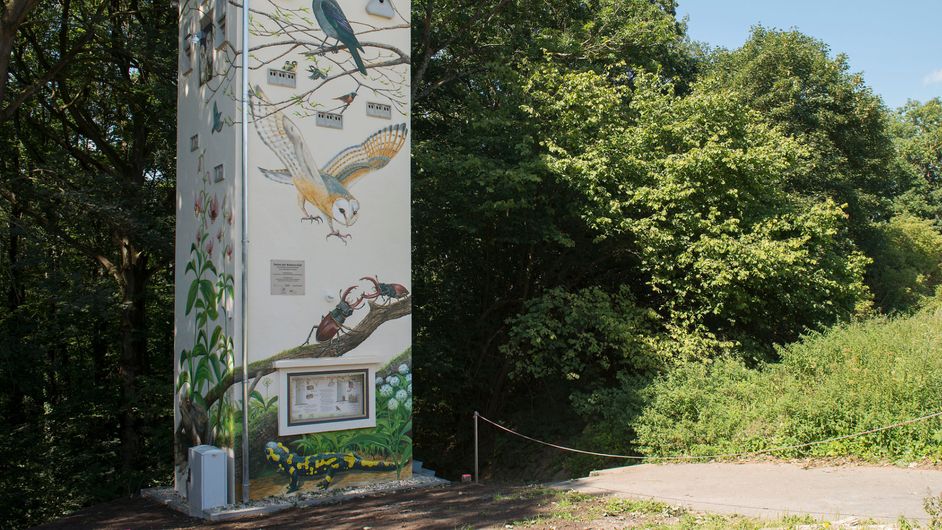
New quarters for animals in the transformer substation
In 2015, Audi Environmental Foundation GmbH inaugurated the first “Column of Biodiversity” at the Vierzehnheiligen (Fourteen Holy Helpers) pilgrimage site at Bad Staffelstein. An old transformer substation has been painted with colorful animals and plants by the artist/nature painter Michael Horn and converted to provide living space for endangered animal species. The aim of the paintings is to attract the attention of walkers to species protection. Information boards provide information on the characteristics, habits and protection status of the endangered species. Endangered animal species, such as the barn owl, greater mouse-eared bat and European orchard bee, should find shelter in the now-completed tower.
Virtual tour of the conservation tower.
Species protection in Suhl
Species protection in Suhl
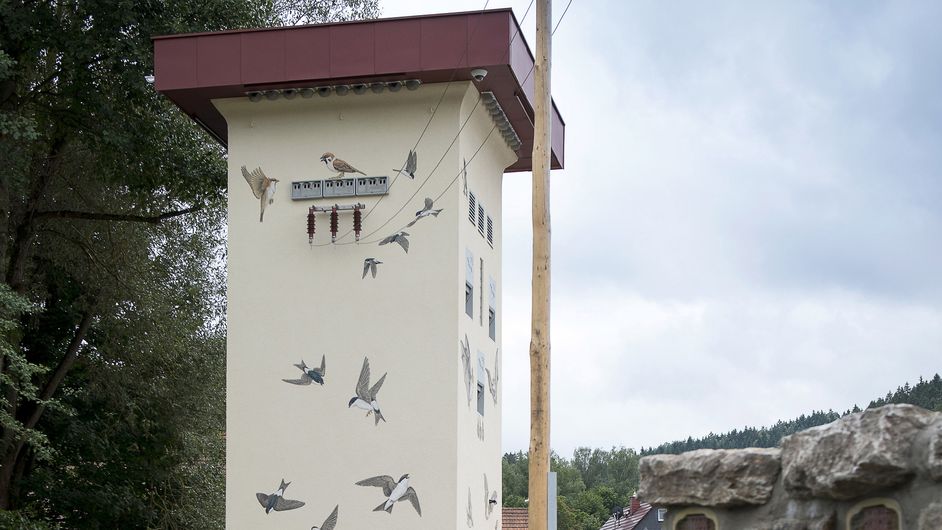
New living space inside and on the exterior of the transformer substation
Together with the city of Suhl, Audi Environmental Foundation GmbH inaugurated a converted transformer substation for endangered animal species on August 26th, 2015. It is the second building that the Environmental Foundation has completed as part of this species protection project. In addition to species protection, environmental education is also a focus of the project. With the installation of webcams, it will be possible to also reach the smartphone and tablet generation and fascinate and inspire them for the preservation of biodiversity and familiarize them with local nature in their own locality. An on-site multimedia information board explains the project to passers-by and is linked to the live stream, which shows life inside the transformer tower.
The little tower in Suhl/Dietzhausen is one of three buildings in the pilot phase of this project in Baden-Württemberg, Bavaria and Thüringen. It has been extensively redesigned with the technical guidance of the Association for Species Protection in Franconia. The special secondary habitats installed in the facade act as a high-quality living space, above all for the house martin, Nathusius’ pipistrelle or the wild bee. Special features of the Thüringen project location: As well as the tower, the external area around it was also converted to simulate conditions found in nature, in order to create further habitats, such as for native birds, reptiles or small mammals. In addition, the course of a nearby stream was improved and a wild-flower meadow was created. A symbolic retained power pole is a reminder of the previous use of the tower and, at the same time, serves as a raised hide for birds - something that is often missing for the animals.
Virtual tour of the conservation tower.
Species-protecting tower Windmill Lechtingen
Species-protecting tower Windmill Lechtingen
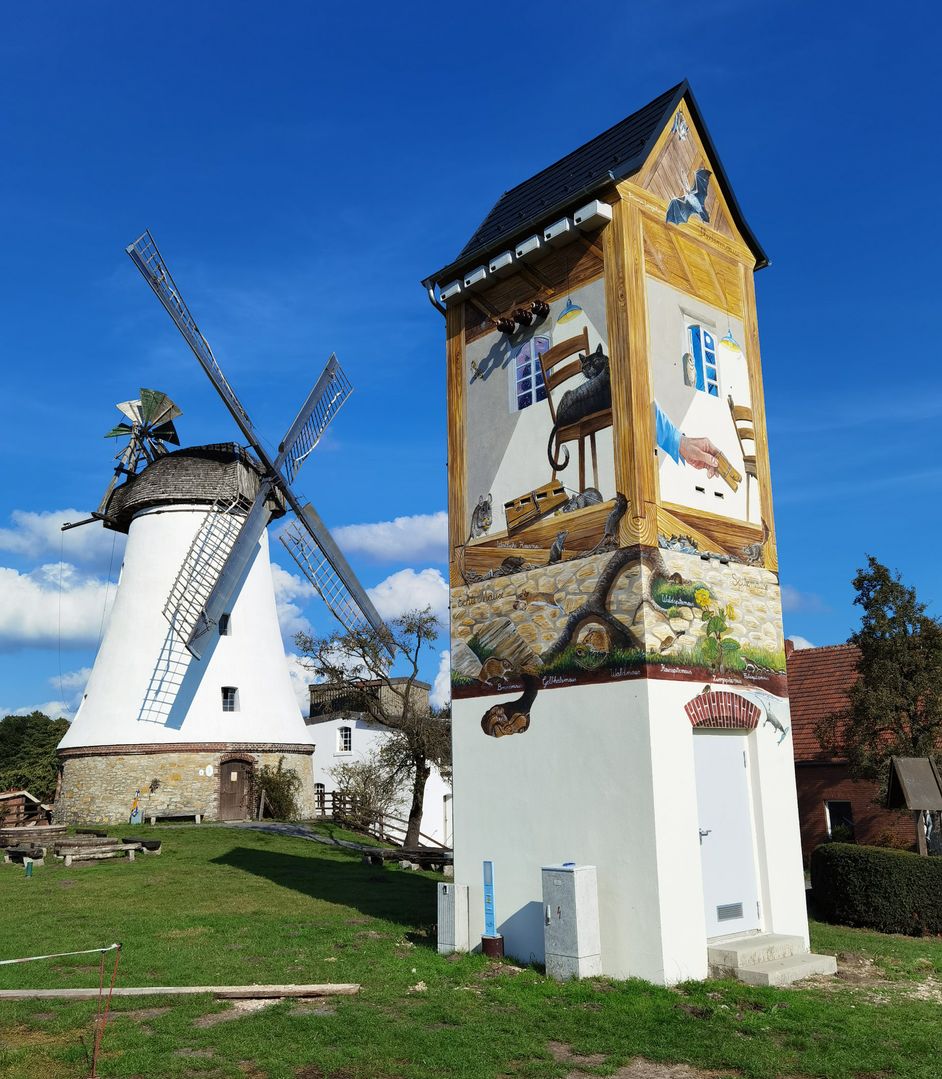
Another highlight started in May 2020. The association “Windmühle Lechtingen e. V.” is restoring the old transformer house next to the windmill. It will be converted into a species protection tower, among others financially supported by “Artenschutz in Franken®” ((Association for Species Protection in Franconia) and the Audi Environmental Foundation. The artistic work was completed in September and the interior work began in October, because the mousetrap museum should find its place inside again.
Over 40 nesting places for birds and bats have been integrated into the outer walls and there is a bat thermal chamber inside the roof. The kestrel nesting box is to be equipped with a webcam.
The exterior painting of the species protection tower has been designed according to the motto “mouse”, matching the mousetrap museum inside. So the tower became a real eye-catcher, which many visitors can enjoy again in the future.
Wild bee walls
Modern species protection and lively environmental education
We are home to around 560 species of wild bees. Over half of them are now threatened with extinction. They fulfill an important function in the ecosystem. We humans depend on the help of bees, because around 2/3 of all food plants are pollinated by wild and honey bees.
They also ensure the survival of many wild plants. There are various reasons why the natural habitat of these busy bees is becoming less and less. Intensive farmland cultivation, increasing land sealing and private gardens that are not very bee-friendly threaten their existence.
With the building of wild bee walls, mainly in kindergartens, the Audi Environment Foundation and its project partner Artenschutz in Franken are committed to the preservation of this endangered insect species. In this way, the children get to know the wild bees' habitat up close. Due to their way of life, wild bees are particularly well suited for this project, as they have no potential for aggression and are therefore generally completely harmless to humans. So young people learn to have respect for animal species and to care about the preservation of biodiversity.
The wild bee wall serves as a habitat for the insects and also provides information on the various wild bee species with lovingly designed information boards. By integrating kindergartens the wild bee wall will represent an environmental education project and research object for species protection in the coming years. In addition to specific species protection, the project aims to reach as many people as possible on this extremely important topic outside of educational centers.
This is a unique project in all of Germany for the concrete conservation of biological diversity and the communication of lively environmental education.
Due to the long-lasting project modules, which are fixed for 20 years, the project also opens up very good options for sustainable and meaningful monitoring. This should provide information about the development of insect populations in Germany.
The nest boxes on the wild bee wall are made of different materials and research is to be carried out which modules are best accepted by which wild bee species and how the brood is developing in them.
The aim is to continue the project nationwide at many other locations in the same or a similar way.
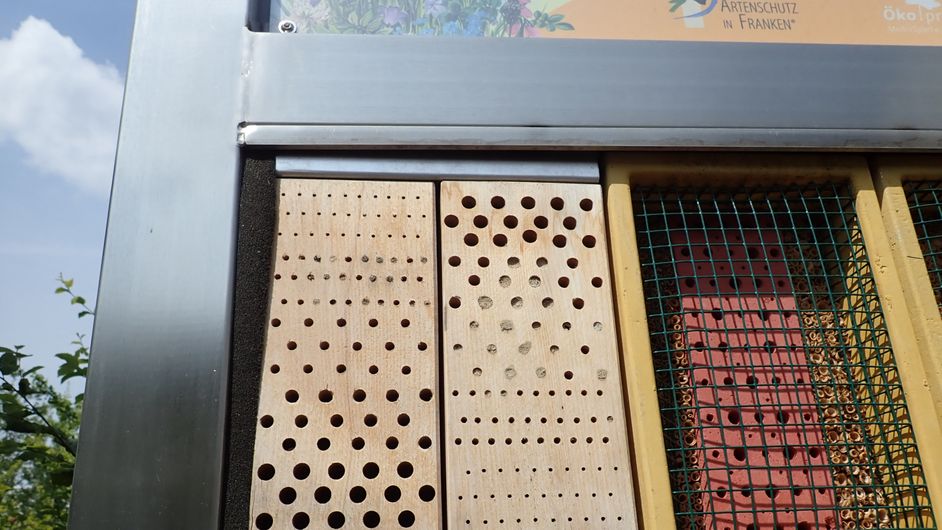
Due to the long-lasting project modules, which are fixed for 20 years, the project also opens up very good options for sustainable and meaningful monitoring. This should provide information about the development of insect populations in Germany.
The nest boxes on the wild bee wall are made of different materials and research is to be carried out which modules are best accepted by which wild bee species and how the brood is developing in them.
The aim is to continue the project nationwide at many other locations in the same or a similar way.
The 'wild bees' of Schönau
The 'wild bees' of Schönau
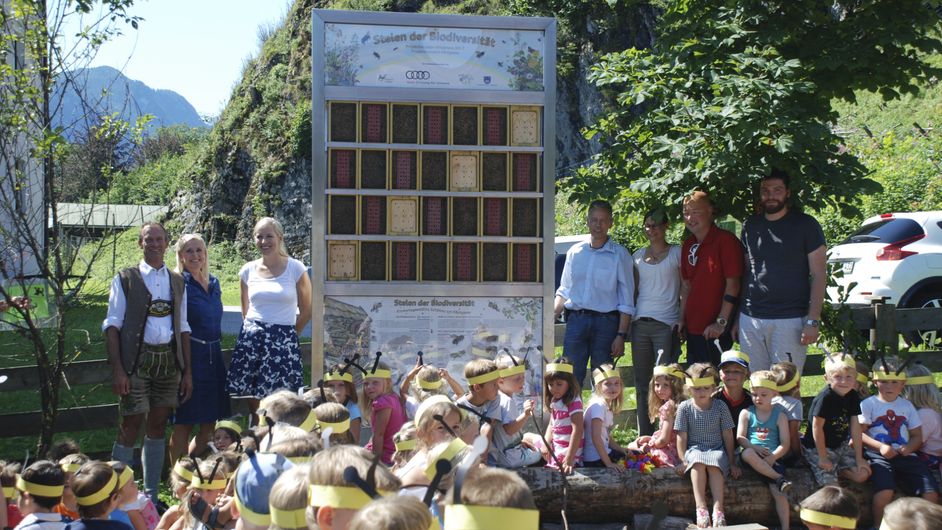
Daycare of Schönau and representatives of Audi Environmental Foundation are pleased by the successful opening ceremony
Modern species protection and lively environmental education are breaking new ground. Artenschutz in Franken (Association of Species protection in Franconia), the Audi Environmental Foundation and the kindergarten of Schönau are working together with the community of Schönau a. Königssee for the preservation of a largely unknown group of insects. This project was implemented by the Association “Artenschutz in Franken” and the community of Schönau. It was financially supported by the Audi Environmental Foundation. The day care center in Schönau contributes the educational elements to environmental project.
The team of the kindergarten Schönau has succeeded in initiating high-quality educational project support. Together with the association “Artenschutz in Franken” it will closely monitor and document the development on the wall in the coming years. With excitement there will also be explored which species are already found and which ones appear subsequently.
The opening ceremony took place on July 21, 2017 in bright sunshine with representatives of the Audi Environmental Foundation and “Artenschutz in Franken”. The inauguration was accompanied by the children of the kindergarten Schönau.
The 'wild bees' of Schönau a. Königssee
The 'wild bees' of Schönau a. Königssee
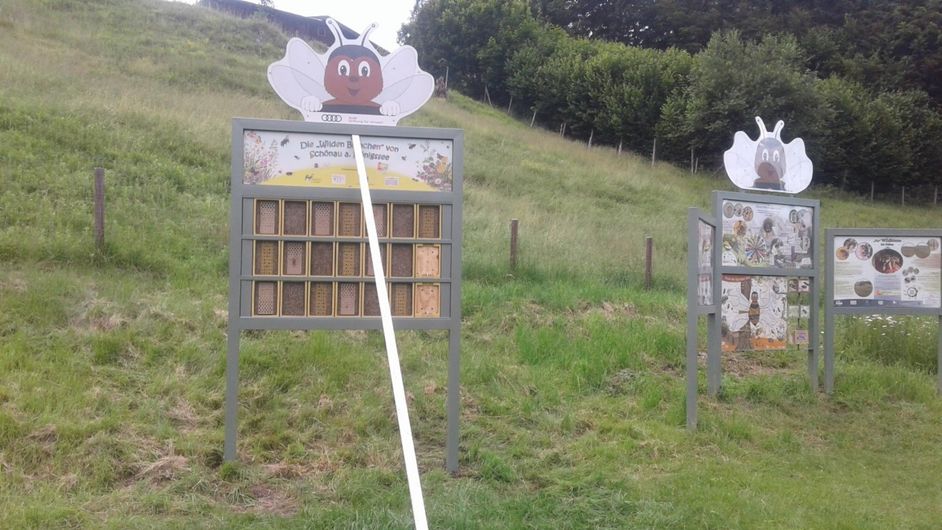
The freshly assembled wild bee wall with support pillars, on the right hand side the information boards
This year, in cooperation with “Artenschutz in Franken” (Association of species protection in Franconia) and the support association of the kindergarten Schönau a. Königssee, another “stele of biodiversity” will be realized. “The wild bees of Schönau a. Königssee”are located on a hiking trail.
In addition to the already existing environmental education units for young people and adults, we also thought of the little ones. The existing information boards were supplemented by a separate information tool for little children, which was co-financed by the Audi Environmental Foundation. In addition, the planned wild bee wall could be erected on June 18, 2020, unfortunately without an inauguration ceremony due to the corona pandemic.
The 'wild bees' of the border triangle
The 'wild bees' of the border triangle
An innovative species protection and environmental education project of “Artenschutz in Franken” ( Association of Species Protection in Franconia) , the daycare of Leukbachtal and the SWSM (Sozialwerk Saar-Mosel gGmbH), which is supported by the Audi Environmental Foundation and the Deutsche Postcode Lotterie, located in the beautiful triangle border area near the tourist attraction Roman Villa Borg .
The daycare Leukbachtal has succeeded in initiating a high-quality educational project support. Together with the association “Artenschutz in Franken”, it will closely monitor and document developments on the wild bee wall in the coming years. It is also eager to research which species are already to be found and which will colonize the wild bee wall later.
Like several others, this location was also recognized as a project of the “UN Decade of Biological Diversity”.
The "Wild Bees" of Magdeburg
The 'wild bees' of Magdeburg
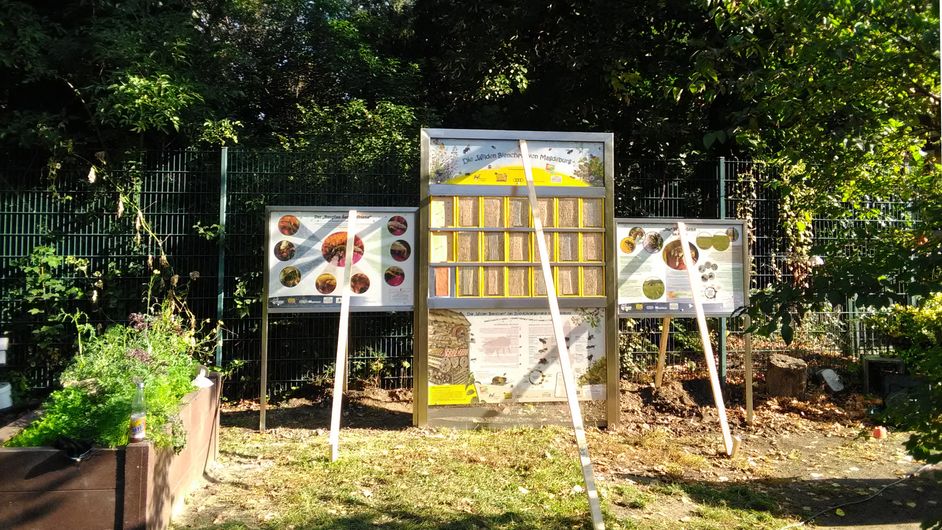
An innovative species protection and environmental education project by the ‘zoo kindergarten Magdeburg’, the Children's House Association and “Artenschutz in Franken” (Association of Species protection in Franconia), which is financially supported by the Audi Environmental Foundation.
The team at the zoo kindergarten of Magdeburg has succeeded in initiating high-quality educational project support. Together with the Association of Species Protection in Franconia, they will closely monitor and document the development on the wall in the coming years. It should also be explored with excitement which species are already to be found and which ones will appear subsequently.
The installation of the wild bee station was successfully completed on September 30, 2020.
The 'wild bees' of Poppenhausen an der Wasserkuppe
The 'wild bees' of Poppenhausen an der Wasserkuppe
An innovative species protection and environmental education project by “Artenschutz in Franken” (Association of Species Protection in Franconia), the “RhönKinder-Haus” kindergarten and the community of Poppenhausen an der Wasserkuppe, which is supported by the Deutsche Postcode Lotterie and the Audi Environmental Foundation.
The team of the RhönKinder-Haus kindergarten has succeeded in initiating high-quality educational project support. Together with the Association for the Protection of Species in Franconia, they will closely monitor and document the development of the wild bee wall in the coming years. It should also be explored with excitement which species are already to be found and which ones will appear subsequently.
The 'wild bees' of Schwerin
The 'wild bees' of Schwerin
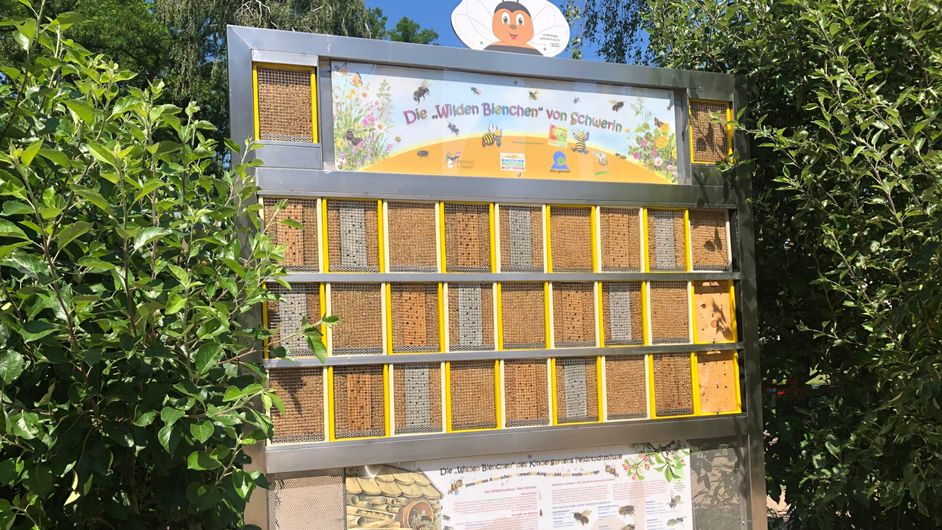
Photo of the wild bee wall in June 2020
An innovative species protection and environmental education project by “Artenschutz in Franken” ( Association of Species Protection in Franconia), the “Feldstadtmäuse Kindergarten” and the Schwerin Kita gGmbH, which is supported by the Deutsche Postcode Lotterie and the Audi Environmental Foundation.
The team at the Feldstadtmäuse kindergarten has succeeded in setting up high-quality educational project support. Together with the Association of Species Protection in Franconia, they will closely monitor and document the development on the wall in the coming years. It should also be explored with excitement which species are already to be found and which ones will appear subsequently.
The installation of the wild bee station was successfully completed on February 18, 2020.
The 'wild bees' of Gottmadingen
The 'wild bees' of Gottmadingen
An innovative species protection and environmental education project of “Artenschutz in Franken” (Association of Species Protection in Franconia), the protestant kindergarten Gottmadingen and the Protestant Church Community Gottmadingen, which is supported by the Audi Environmental Foundation, the Margarete Müller-Bull Foundation and the Landesbank Baden-Württemberg Foundation.
The species protection and environmental education wall was successfully installed on November 20, 2018. Furthermore, nesting modules that have been modified are also introduced.
Representatives of the Audi Environmental Foundation were invited, when around 40 boys and girls were able to complete the environmental education day in July 2019. Various wild bee species have already settled on the wild bee wall.
The 'wild bees' of Kaulsdorf
The 'wild bees' of Kaulsdorf
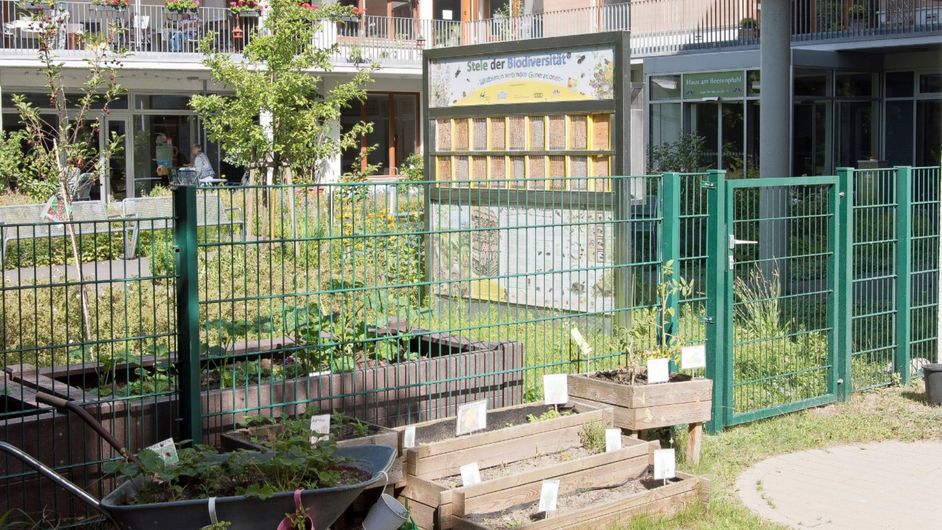
Wild bee wall with a connecting door between the generations
Modern species protection and lively environmental education are breaking new ground. “Artenschutz in Franken” (Association of Species Protection in Franconia), the Kaulsdorf-Nord nursing home center and the kindergarten “Am Beerenpfuhl” are working together in an innovative way to preserve a largely unknown group of insects. They are supported by the Audi Environmental Foundation and the Deutsche Postcode Lottery. There is a kindergarten next to the care center for elder people, so different generations can participate intensively and experience first-hand how wild bees move in the urban environment. A piece of wilderness that we are making visible in the federal capital of Berlin.
The wild bee wall was installed on the grounds of the care home center on February 17, 2020. In order to give the children of the kindergarten the opportunity to visit the wild bees wall and the plant beds every day, a small garden door was installed, which serves as a connection between the older and younger generation.
At the beginning of September 2019, a "bee day" took place at the facility - where residents and visitors could learn a lot about the importance of the small insects. The urban environment in particular offers great opportunities to give some wild bee species a chance to survive that they can hardly find in an increasingly cleared landscape. In addition to the honey bee colonies living and cared for here, the wild bee species are the backbone for the conservation of cultivated and wild plants. This path must be pursued intensively nationwide and should be implemented in as many places as possible.
Two additional information boards for adults were installed on the back of the freestanding wall, the larger font size was chosen so that older people can read the texts easily.
The front area beneath the wall once again is reserved for the children of the nearby day care center and, due to the available space, two further educational components could be added.
The 'wild bees' of Munich
The 'wild bees' of Munich
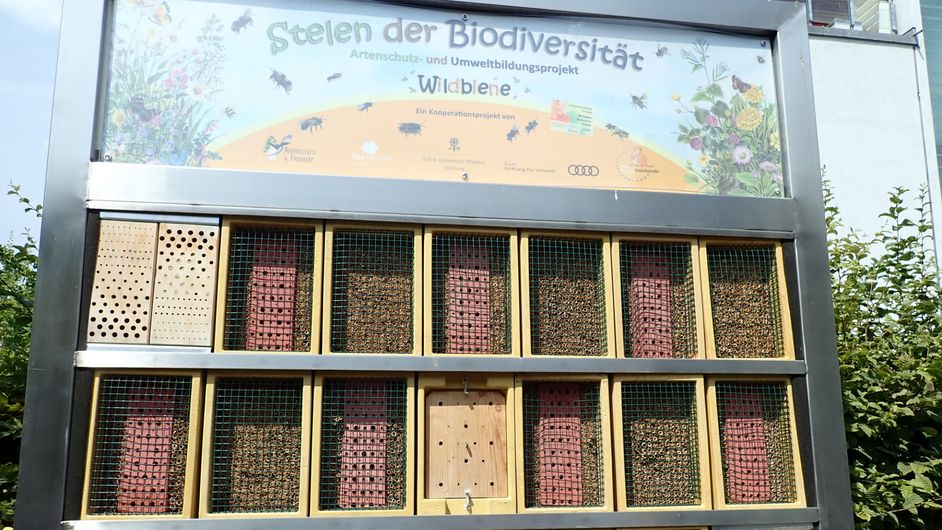
An innovative species protection and environmental education project by “Artenschutz in Franken (Association of Species Protection in Franconia) and the kindergarten Helsinkistraße in Munich, which is co-financed by the Audi Environmental Foundation. The wild bee wall was installed on October 30, 2018. The official opening took place later in July 2019 with representatives of the supporting organizations.
The team at the kindergarten Helsinkistraße has succeeded in setting up high-quality educational project support. Together with the Association of Species Protection in Franconia, they will closely monitor and document the development on the wall in the coming years. It should also be observed with excitement which species are already to be found and which ones will appear subsequently.
